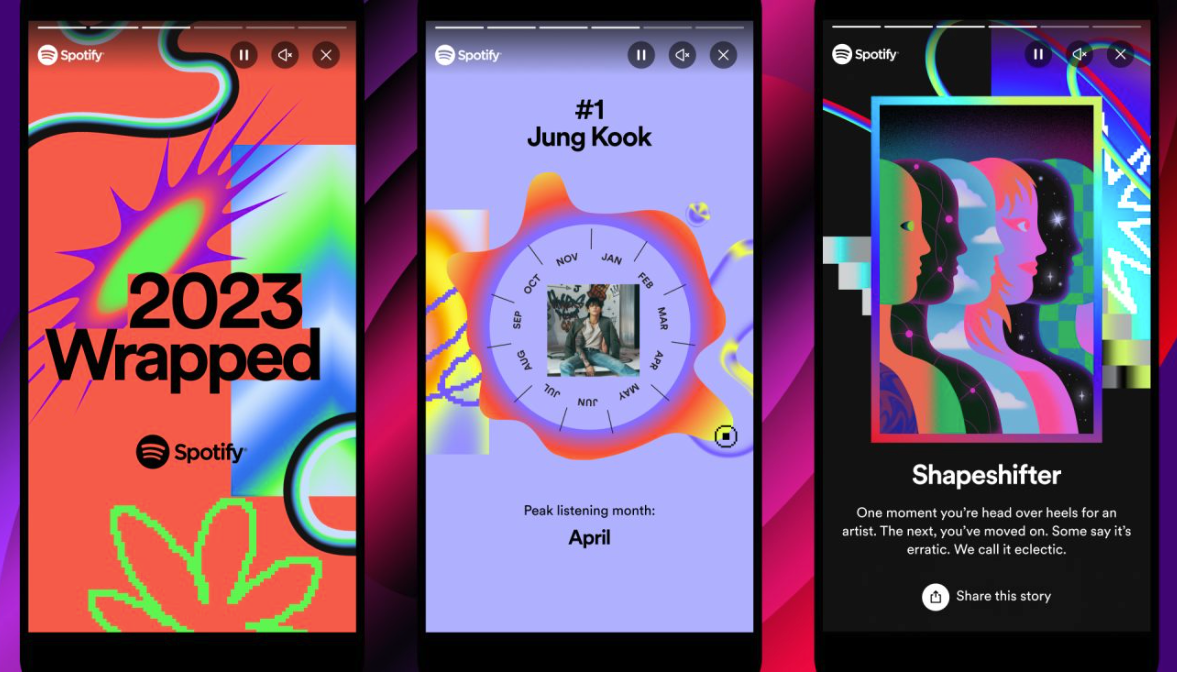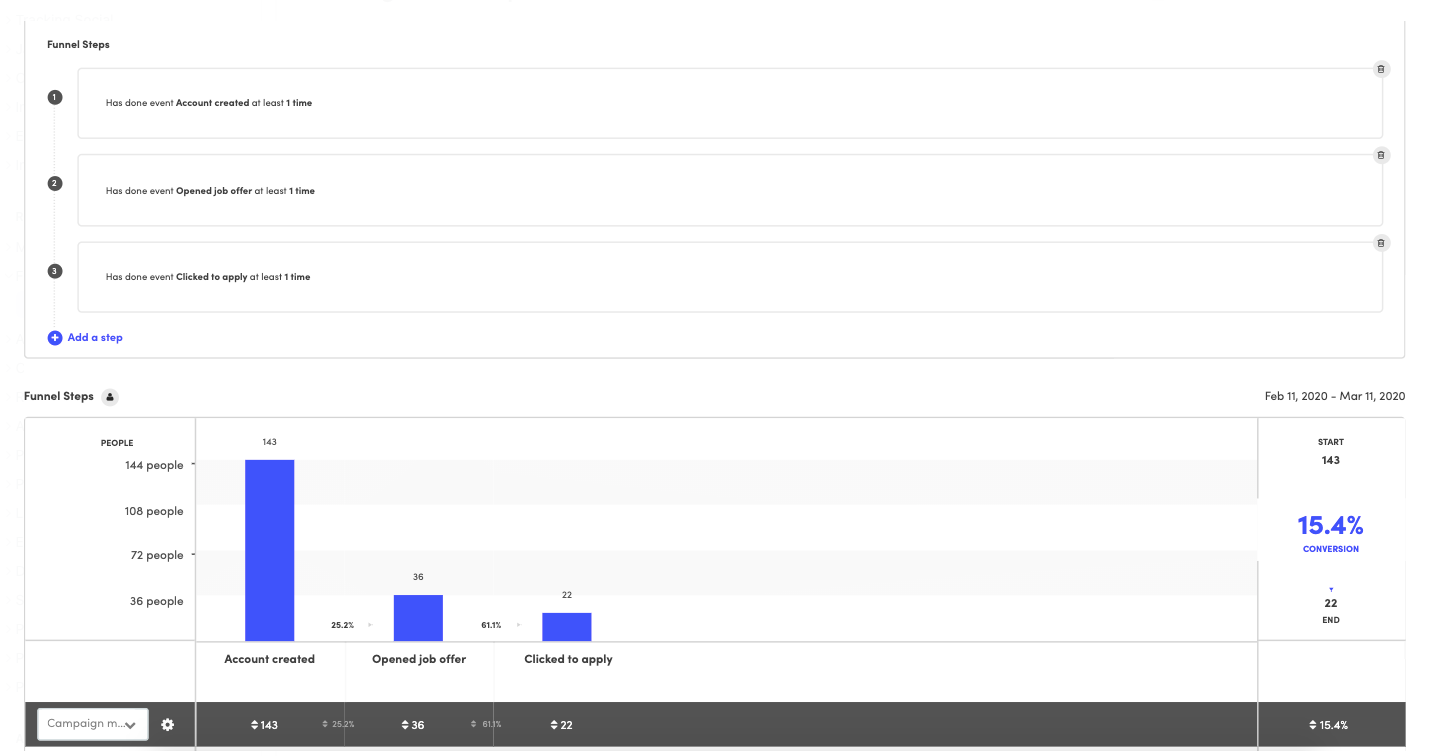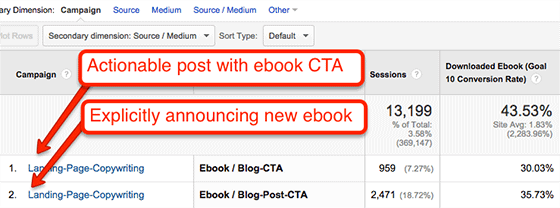
The ultimate guide to running successful marketing campaigns
On marketing blogs everywhere (including this one), you hear a lot of lip service about the importance of meticulously planning your marketing campaigns.
But what many don’t address is that marketing campaigns aren’t just for product launches and promotions—if you want to achieve measurable results with your marketing, you need to treat every single one of your marketing activities as a marketing campaign.
TABLE OF CONTENTS
For every single project you take on to move the needle for your business, you’ve got to have a master plan: a set of clearly-defined goals, a finite start and end date, and a means of tracking your successes (and failures).
So what extra baggage comes with this “campaign mentality”? What’s the ideal order of operations? What extra resources will you need
Here’s a step-by-step blueprint for planning and launching your next campaign—with a selection of useful tools to help you through each step and some inspirational examples to help you get started.
What is a marketing campaign?
A marketing campaign is a focused strategy that uses coordinated marketing activities to achieve a specific business goal. It’s like a movie with a beginning, middle, and end—carefully planned to create maximum impact for your brand.
Every successful campaign shares three essential ingredients: a clear target audience, a compelling message, and a defined timeframe to measure success. Whether you’re launching a new product, boosting brand awareness, or driving sales, a marketing campaign turns random marketing efforts into a powerful force with purpose.
Here are the key parts of a marketing campaign:
- Targeted approach: Effective campaigns don’t blast messages into the void. They’re laser-focused on a clearly defined target audience, using the right channels to reach them—think email, social media, eye-catching landing pages, or even old-school print ads.
- Strategic steps: Great campaigns aren’t random acts of marketing. They involve a carefully crafted sequence of activities, all working together to achieve your objectives. This might include crafting irresistible content, running targeted ads, or hosting engaging webinars.
- Measurable impact: The best campaigns are data-driven. You should be able to track and measure their success, whether it’s increased website traffic, higher conversion rates, or a surge in brand mentions.
So, why are marketing campaigns so important? Because they deliver real results, like:
- Increased brand awareness: Targeted campaigns put your brand on the map, making you a household name (or at least a name people recognize in their social feeds).
- Customer acquisition: Effective campaigns attract new customers, turning interested window-shoppers into loyal fans.
- Better ROI: While some marketing channels require investment, campaigns can be surprisingly cost-effective—especially when you target the right audience and measure results.
What makes a marketing campaign successful?
What separates the marketing campaigns that soar from those that sink? It’s not just creativity or budget—though both help.
Successful campaigns connect emotionally with their audience while delivering clear value. They tell a compelling story that resonates with real people’s needs and desires. The best campaigns also maintain consistency across all touchpoints while having the flexibility to evolve based on data.
Behind every winning campaign is purposeful planning, measurable goals, and a willingness to take calculated risks. Great campaigns don’t just capture attention—they inspire action and create lasting impressions that stick with audiences long after the campaign ends.
9 of the most successful marketing campaigns (and why they’re so effective)
Okay, now let’s dive into nine examples of marketing campaigns that have not just floated but truly soared—hopefully they can spark some ideas and illuminate the path for your own strategies. Each campaign is a blend of creativity, insight, and sometimes, just the right amount of boldness, perfectly encapsulating the essence of what it means to connect and convert.
1. Dollar Shave Club: F**king Great Razors

Dollar Shave Club created a hilarious, irreverent YouTube ad boasting about the quality and affordability of their razors.
Why it worked:
- Bold humor: Cut through the clutter with unexpected humor, grabbing attention and making it memorable.
- Targeted audience: Spoke directly to a specific audience (millennial men) with their language and tone.
- Transparency: Avoided the typical marketing fluff and offered a refreshingly honest message.
2. Dove: Real Beauty

Dove’s long-running campaign celebrates diverse beauty standards and promotes self-confidence in women.
Why it worked:
- Positive message: Challenged unrealistic beauty standards and empowered women to embrace their individuality.
- Social impact: Opened a conversation about societal perceptions of beauty, fostering brand purpose.
- Targeted content: Developed content that resonated with a wide range of women, building a strong community.
3. Red Bull: Stratos

Daredevil Felix Baumgartner took a daring skydiving jump from the edge of space, sponsored by Red Bull.
Why it worked:
- Event marketing: Leveraged a thrilling, record-breaking event to generate massive global buzz.
- Brand association: Connected Red Bull with the ideas of pushing boundaries and achieving the impossible.
- Multi-platform experience: Livestreamed the jump across various platforms, creating a real-time interactive experience.
4. Spotify: Wrapped

Since 2016, at the end of every year Spotify provides personalized (and visually vivid) insights into users’ listening habits.
Why it worked:
- Data-driven personalization: Used user data to create a unique and engaging experience for each customer.
- Social sharing: Encouraged users to share their Wrapped results on social media, extending campaign reach.
- FOMO factor: Tapped into the “fear of missing out” by showcasing users’ unique listening habits.
5. Always: Like a Girl

Always created a powerful video ad challenging the negative connotations associated with the phrase “like a girl”.
Why it worked:
- Social impact: Opened an important conversation about gender stereotypes and empowered young girls.
- Emotional connection: The video evoked strong emotions and resonated with a broad audience.
- Increased brand affinity: Showcased Always as a brand that cares about its customers’ well-being.
6. Airbnb: #WeAccept

This Airbnb campaign promoted diversity and acceptance, highlighting Airbnb’s commitment to provide accommodation for everyone.
Why it worked:
- Social stance: Positioned Airbnb as a brand with strong, positive values.
- Community building: Fostered a sense of belonging among users and hosts.
- Authentic stories: Used real stories to create emotional connections.
7. ALS: Ice Bucket Challenge

This viral challenge raised awareness and funds for ALS (amyotrophic lateral sclerosis, otherwise known as Lou Gehrig’s disease) research.
Why it worked:
- Viral mechanism: The challenge aspect made it spread like wildfire.
- Celebrity participation: Gained visibility with celebrity involvement.
- Massive impact: Raised significant funds and awareness for ALS, demonstrating the power of social media for social good.
8. Patagonia: Don’t Buy This Jacket

In 2011 Patagonia placed an ad in the New York Times urging consumers to consider the environmental impact of their purchases and even advising against buying Patagonia products unless necessary.
Why it worked:
- Bold messaging: Stood out by going against the grain of typical consumerism.
- Brand integrity: Reinforced Patagonia’s commitment to environmental responsibility.
- Consumer trust: Built trust by prioritizing values over sales.
9. LEGO: Rebuild the World

This fun and lighthearted campaign from LEGO encouraged creativity and the endless possibilities of building with LEGO.
Why it worked:
- Inspiring creativity: Appeals to both children and adults by celebrating imagination.
- Brand mission: Aligns with Lego’s mission to inspire and develop the builders of tomorrow.
- Global engagement: Engages a global audience with a universal message of creativity.
How to create a successful marketing campaign: Best practices with a step-by-step process
Ready to transform your marketing efforts from a guessing game to a conversion-generating masterpiece? Let’s dive into the step-by-step process of creating a marketing campaign that will have your audience singing your praises.
Step 1: Ideation, research, and goal setting
Have a brilliant idea
We’re willing to bet that you’ve got more brilliant ideas floating around than you realize—but are they getting lost in the shuffle? Organizing your ideas goes a long way in helping to identify the opportunities with the most potential.
A good way to stay organized and keep on track is to use a task management tool like Trello, Asana, Monday, Wrike, or many others. Tools like these can help you and your team stay on track and on deadline.
Start brainstorming ideas, and for each campaign idea identify the scope of the project:
- How long will it take?
- What resources will it require?
- What sort of results do you expect?
As each campaign gets off the ground, move the project through each stage of the planning process and update the status so everyone can see the progress you’re making.
Organizing things in this way helps you prioritize and holds you accountable for your ideas from start to finish.
Know your audience and what resonates
When validating ideas, always keep your audience top-of-mind.
Ask yourself:
- Which part of the marketing funnel are you targeting? What sort of content or campaign will resonate with those prospects?
- Which topics are popular with your audience? Which of your campaigns have resonated in the past? Which ones have failed miserably?
- What is there a need for? Are the same questions appearing in blog comments, on social channels and with your customer support team?
Always ask yourself how you can deliver as much value as possible to your prospects. There’s a reason why people say, “The customer is always right”—at the end of the day, if you give them what they want, they’ll thank you by converting.
Be as specific as possible when setting goals
Once you’ve identified a ripe opportunity, get super specific about what you expect from the marketing campaign. I’m not talking about simply declaring that you “want more sales”.🤞🏼 You want to be as specific as possible so you can measure your success later.
For example, when we launched our Conversion Marketer’s Guide to Landing Page Copywriting, here were the results we estimated:
- 5,000 downloads
- 1,000 new leads
- 100 new trial starts
Ask yourself which key performance indicators matter most to your business and what results you can expect. If you don’t have previous campaigns to refer to, take your best guess. At the very worst, you’ll be way off and will have more realistic expectations next time.
A good way to make sure your goal-setting is effective and useful is to use the SMART framework, like we mentioned earlier.
Step 2: Building (and testing) your campaign landing page
If you want your campaigns to inspire action, then you’ve got to make the intended goal crystal-clear. After all, your users deserve a delightful, seamless marketing experience, don’t they?
If you agree (and of course you do), then you’ve got to create a dedicated landing page for every marketing campaign you launch.
Creating a dedicated landing page for every marketing campaign allows you to direct prospects toward the goal in a concise, compelling manner—and allows you to easily track the success of your campaign.
Use the five elements of a high-converting landing page
Every campaign landing page should lead with the question that prospects have on the brain: “What’s in it for me?”
That includes talking about benefits, not features. If you’re not sure about the difference between them, here’s an example: Power windows in a car are a feature, and the corresponding benefit is that you can open all the windows quickly and conveniently.
By providing details about benefits, you can supply prospects with all the information they need to make a decision. A simple way to achieve this is to be sure that your landing page includes the five essential elements of a winning landing page:
- Unique value proposition
- Hero shot
- Benefits
- Social proof
- Call to action
Here’s part of an infographic that shows you how these elements can work together on a landing page:

Click to see the full infographic.
Once you’ve got all the elements in there, don’t forget to test your heart out. Checking “hero shot” off the list isn’t enough. You’ve got to make sure that you’ve got a strong, effective image that will help create the impact you’re looking for.
Ask if video can add value
Sometimes, your offer is hard to summarize above the fold. Maybe it’s a complex offering, or maybe you want to show your product in action so prospects can picture themselves using it.
Including a video on your landing page (with the help of a service such as Wistia) could be exactly what you need to counter objections that prospects have when they just don’t get what you do or what you offer.
But does video really work?
We could point you to an article that indicates that videos increase conversions on landing pages. We could also link to one that suggests the opposite.
Either way, one thing is certain: A/B testing is your friend.
If you do go with video, remember that it’s a time-intensive venture that will require lots of resources. Make sure you’re not neglecting the other important elements on your landing page. ‘Cause if your copy falls flat, your video won’t shine either.
Set up the delivery mechanism
As people fill out the form on your landing page, you want them to be added to a relevant list that you’ve created in your email service provider. Create a dedicated list or segment for that campaign so you can track signups easily and keep in touch.
Then add a follow-up message that delivers the offering, or deliver it on the confirmation page. Don’t leave anyone hanging!
Step 3: Setting up goal tracking
If you’re going to invest time and resources into your brilliant ideas, you’ll want to know how your campaign is performing.
Google Analytics can be useful in tracking straightforward goals and conversions (such as an ebook download),but campaigns often involve more than one touchpoint with prospects.
Go deep with your analytics
Tools like Kissmetrics make it easier to tag your campaign data and build a simple custom report to display results. We’ve found it extremely valuable that the tool allows you to pull customer data from your billing system so you can accurately track their progress all the way down the funnel—and even after they become a customer.
For each campaign, you’ll want to set up events for every micro and macro conversion. For example, you may want to set up an event when a prospect completes each of the following:
- Visits the campaign landing page
- Signs up for a free 30-day trial
- Uses your product
Then you can set up funnel reports so you can see the point at which people are dropping off—and optimize accordingly.

An example of a simple funnel report from Kissmetrics.
To get started with goal tracking, check out this helpful guide.
Step 4: Distribution and campaign promotion
After you’ve created all the things and set up all the tracking, you’ve gotta devise a game plan for getting it all out there. Which channels will you use to promote your campaign? Email, co-marketing initiatives, social, PPC, press releases, or maybe even a contest?
Whichever channels you choose, remember that distribution and promotion should never be an afterthought. All this prep work should run parallel to content production so that much of the legwork is done before your launch date.
Social media announcement
Your fans on social media have followed you because they’re interested in what you’re doing and what you have to say. So tell ‘em what’s up!
Every marketing campaign needs a corresponding social media campaign to spread the word. At the very least, you should:
- Create a variety of social assets that have a design and message that match with the landing page you created earlier.
- Tag the URLs you are using to distribute content on social so you can measure the results of your campaign (check out a simple tutorial on that).
- Schedule promotional messages in advance with tools like Hootsuite to coincide with the launch date and avoid last-minute scrambles.
- Keep your ear to the ground on social media to collect feedback and respond to comments/questions about your campaign.
Blog post announcement
If you’ve already got a group of engaged readers on your blog, why not use it as a platform to break the news about your campaign?
You could write a post on a related subject to pique your readers’ interest, and then insert a CTA at the bottom of the post for your campaign. Or just write a post that simply announces the launch! (Sometimes the direct approach is best.)
When we launched our copywriting ebook, we found that explicitly announcing the launch (rather than burying a CTA in a post with related subject matter) resulted in more sessions and downloads:

Explicitly announcing the launch of our latest ebook (instead of burying the lede in a post on the same subject) resulted in more views to the campaign landing page and a higher percentage of ebook downloads.
Your campaign may have a finite end date, but your blog post is around forever—so make sure that you pay attention to SEO and do appropriate keyword research.
If you’re running an evergreen campaign, also consider optimizing your landing page for SEO so that people can stumble on it organically. (Psst: If you’re an SEO noob, tools like Moz can help.)
Email announcement
If you’ve already got an engaged mailing list, announcing your campaign via email is an easy win. After all, these people have already self-identified as being interested in what you do.
Here are some best practices to help get you started:
- Make sure your email copy matches that of your landing page.
- According to copywriting expert Joanna Wiebe, your subject line has one job: to get the prospect to open the email. It needs to grab the reader’s attention, but should still be clear. Test subject lines to learn more about what triggers subscribers to open.
- Your body copy should be concise, and speak clearly to the benefits of your campaign. Your body copy’s “job” is to get people to click on the CTA in the email.
- The CTA in your email has to pop and describe what people get when they click the button. Test CTA button copy that answers the question, “I want to…”
- If you’re not really into copywriting, no problem—we’ve got a great writing tool that can do it for you.
Announcing through content marketing
Each of these tactics leverages content marketing’s power to not just announce your campaign but to amplify it, creating a multifaceted experience that educates, engages, and excites your audience.
- Writing a blog post: Kick off your campaign with a compelling blog post that mixes storytelling with valuable insights, setting the stage for what’s to come and sparking interest.
- Holding a webinar: Dive deeper into the campaign’s theme with an interactive webinar, offering a platform for live engagement, expert discussions, and real-time Q&A to enrich understanding and connection.
- Recording a podcast: Use the intimate and accessible format of a podcast to discuss your campaign in detail, giving your message a personal touch and reaching your audience wherever they are.
- Creating a shareable infographic: Distill the essence of your campaign into an eye-catching infographic that simplifies complex information into an easy-to-share visual, boosting visibility and engagement on social media.
Announcing through PPC ads
Pay-per-click (PPC) marketing can be a powerful tool to get the word out about your new marketing campaign. Here’s how you can leverage PPC effectively:
- Check your competitors’ messaging: Analyze the PPC ads of your competitors to understand their messaging strategy. This can give you insights into what works in your industry and help you differentiate your campaign.
- Do keyword research: Use keyword research tools to find terms your target audience is searching for. Craft your PPC ads using this language to ensure your message resonates and connects with them directly
- Align your paid ad assets: Ensure that your PPC ads visually and thematically align with the landing page they link to. This consistency boosts user trust and increases the likelihood of conversion by providing a seamless experience from ad to landing page.
There are, of course, tons of other methods for getting your campaign out there, including PR, sponsorships, and more. You’ve got to find what works best for you—and then find ways to do it better than everyone else.
Step 5: Lead nurturing
After your campaign is launched, your work isn’t done. No matter the goal of your campaign, you want to continue the relationship so you can turn leads into customers and customers into repeat customers.
We’re talking about lead nurturing. The more touchpoints a lead has with your business, the hotter they become.

You’ll want to keep track of those interactions (customer relationship management or CRM tools can help make this easy)—and then find ways to evolve your relationship.
Keep delivering value
The more details you have about your leads, the more opportunities you have to send them targeted offers that will make them happy—and more likely to do business with you.
When we recently launched an ebook campaign, we set up separate email marketing campaigns to fire based on answers prospects provided in the opt-in form.
For example, the form included this question: How do you build landing pages? If they answered “We don’t use landing pages”, we sent them a follow-up email schooling them about the importance of landing pages (and how Unbounce can help them create really effective pages).
Taking this approach gave us insight into the behavior of each subscriber, and allowed us to target subsequent offers based on their answers.
If you listen closely enough, you’ll have a good idea of what your prospects want. And that puts you in the unique position to give them exactly what they need.
Step 6: Lather, rinse, repeat
When your campaign has come to an end, it’s time to look back and take in all the results.
Hold a postmortem with everyone involved to discuss your successes and shortcomings. For example:
- Did you meet the goals you laid out in step #1?
- What could have been done differently?
- For anything that didn’t work out, what’s your best guess at why it went wrong?
- How can you do things better next time?
- What have you learned about your audience?
Holding meetings like this and keeping the notes on record allows the entire team to learn from everyone’s experiences and become better marketers.
And that will make your next marketing campaign that much more awesome.
What’s the difference between a marketing campaign and an advertising campaign?
In the fast-paced world of marketing, terminology can get tossed around like a hot potato. Two terms that often get confused are “marketing campaigns” and “advertising campaigns”. While they work hand-in-hand, there’s a key distinction between the two.
Picture this: a marketing campaign is like the grand plan for your brand’s gala—an elaborate blueprint that covers everything from the invitations (target audience engagement) to the decor (branding) and the menu (product or service offerings). A marketing campaign is a comprehensive strategy aimed at achieving a specific goal, be it launching a new product, entering a new market, or enhancing customer engagement. It employs a smorgasbord of tactics—advertising being just one of the courses.
On the other hand, an ad campaign is often a subset of the grander marketing campaign, laser-focused on promoting a particular product or service through paid channels. It’s like a series of captivating flyers, enticing social media posts, and eye-catching billboards you create to spread the word about the gala. The aim? To catch the eye, stir the imagination, and, ultimately, drive the audience to RSVP “yes!”.
Here’s the lowdown on the key differences:
- Scope and strategy: A marketing campaign is the master plan, encompassing various elements like market research, product development, and customer service. Advertising campaigns are the specialized troops, deployed to deliver persuasive messages through selected media.
- Objective and outcome: The endgame of a marketing campaign is broader—brand awareness, market penetration, or customer loyalty. Advertising campaigns, however, aim for immediate visibility and action, such as clicks, views, or purchases.
- Tools and tactics: Marketing campaigns wield a diverse arsenal—from PR efforts and social media engagement to content marketing and SEO. Advertising campaigns, though, often rely on paid media spots to charm their way into the audience’s consciousness.
11 components the best marketing campaigns often share
Alright, now let’s dive into the nitty-gritty of crafting a marketing campaign that not only grabs attention but also holds it tighter than a toddler with a new toy. In the bustling world of marketing, understanding the components of a successful campaign is like finding a map in a treasure hunt. So, buckle up as we navigate through the essential elements that’ll help launch your campaign into the stratosphere.
1. Determining goals and key performance indicators (KPIs)
Every epic journey starts with a single step, and in the world of marketing, that step is defining your goals and KPIs. Think of your goals as the destination postcard you’re sending to your future self, while KPIs are the quirky travel guides making sure you get there.
Whether you’re aiming to boost brand awareness, increase website traffic, or skyrocket sales, setting clear, measurable goals and identifying the KPIs to track them is like packing your suitcase with the essentials—minus the extra pair of socks you’ll never wear.
Pro tip: SMART goals are your friend. Make your goals Specific, Measurable, Achievable, Relevant, and Time-bound.
2. Understanding your target audience
Knowing your target audience is like having a secret decoder ring that translates your message into “Oh, this is for me!” moments. It’s not just about demographics—it’s about getting into the nitty-gritty of their desires, challenges, and daily lives. Imagine you’re inviting them to the most exclusive party of the year—your campaign. You need to know what makes them tick so you can craft an invite that’s impossible to ignore.
Personas are useful for gaining insights into your potential customers. You can craft detailed buyer personas that go beyond demographics by asking questions like “What are their aspirations?” and “What challenges do they face?”.
3. Clearly defining the outcome
Every marketing campaign should have a clearly defined outcome, a beacon of success that you’re aiming for. It’s the difference between “let’s just see what happens” and “here’s where we’re going, folks.” This outcome guides your strategy, helping you to steer clear of the tempting but treacherous waters of aimlessness.
Or, to put it another way:

4. Selecting the right channels or mediums
Choosing the most effective media channels for your campaign is like picking the perfect outfit for an event. You want to show up where your audience hangs out, in a style that speaks to them. Whether it’s social media, email, or skywriting (if you’re feeling particularly extravagant), selecting the right channels is crucial for ensuring your message is seen by the right eyes.
Explore options like:
- Social media for brand awareness and community building
- Email marketing for targeted communication and lead nurturing
- Content marketing for thought leadership and attracting qualified leads
- Paid advertising (PPC) for reaching a wider audience and driving conversions
- Public relations for generating positive media coverage and brand credibility
5. Establishing the budget
Ah, the budget. It’s the gravity that keeps your lofty campaign dreams from floating away into the stratosphere. Determining your budget upfront helps allocate resources wisely, ensuring you have enough fuel to reach your destination without having to hitchhike back. It’s all about getting the biggest bang for your buck or, more to the point, the most conversions for your cash.
6. Including a call to action (CTA)
The call to action is your campaign’s mic drop. It’s what you want your audience to do after they’ve encountered your message, whether it’s “Sign up”, “Buy now”, or “Learn more”. Your CTA should be as clear and compelling as a neon sign in a dimly lit alley, guiding your audience towards the action you want them to take.
Recommended Reading: 15 irresistible call to action examples that’ll get results
7. Diversifying the content formats
Diversity is the spice of life, and the same goes for content formats in your marketing campaign. Mixing it up with video ads, press releases, and guest blogs keeps your audience engaged and entertained. It’s like hosting a dinner party with a menu that has something for everyone, ensuring all your guests leave satisfied.
8. Creating marketing content
Crafting and designing your marketing content is where creativity meets strategy. It’s the stage where you bring your campaign to life, infusing your message with the kind of creativity that makes people stop and stare. Whether it’s through eye-catching visuals, witty copy, or compelling storytelling, your content is the vehicle that delivers your message to the world.
9. Assembling a good team
Behind every successful marketing campaign is a stellar team, each member bringing their own specialized skills to the table. From strategists and writers to designers and analysts, identifying and rallying your team is essential for bringing your campaign vision to life. It’s the dream team effect, where collaboration and expertise combine to create something truly spectacular.
10. Defining the core message or purpose
Every marketing campaign needs a central message—the “why” behind your efforts. It’s what connects your campaign to your audience on a deeper level, turning what could be just another ad into a meaningful conversation. Your message should resonate with your audience’s values and aspirations, creating a sense of shared purpose.
11. Analyzing the results and making notes for future campaigns
The end of a campaign can lay the groundwork for the next adventure. Analyzing the results and making notes for future campaigns is like gathering the treasure you’ve found and mapping out the next quest. It’s an opportunity to learn what worked, what didn’t, and how you can refine your strategy to make the next campaign even more successful.
Each of the elements above plays a crucial role in crafting a campaign that not only reaches but resonates with your audience, driving them to action. Remember, the magic is in the mix, so blend these components with creativity, strategy, and insight to create marketing campaigns that truly stand out.
How to measure the success of your marketing campaign
Measuring a campaign’s success isn’t just about counting beans (or likes, or retweets)—it’s about understanding how those numbers translate into real-world impact. Here’s how to tell if your campaign is the marketing equivalent of a moon landing or just a firework that fizzled out.
Sales revenue: The ultimate scoreboard
Let’s be honest, this is the ultimate gold medal. Tracking sales revenue directly attributable to your campaign shows you if your marketing efforts are driving the most important outcome: boosting your bottom line.
Customer retention: Keeping the party going
It’s not just about snagging new customers, it’s about keeping them happy and coming back for more. Look at metrics like repeat purchase rates and customer lifetime value to see if your campaign is fostering brand loyalty.
Return on investment (ROI): Making your money matter
Marketing is an investment, and you deserve to see a return. ROI measures how much revenue you generate for every dollar spent on your campaign. It’s a fantastic way to assess your campaign’s efficiency and identify areas for improvement.
Calculating ROI involves subtracting the cost of your marketing campaign from the generated revenue and then dividing that number by the campaign cost. If the result is higher than your grandma’s age, you’re partying. If it’s looking more like your little cousin’s shoe size, it might be time to rethink your strategy.
Cost per lead (CPL): Are those leads worth the loot?
Not all leads are created equal. CPL tracks how much it costs to acquire a new lead. This metric helps you determine if your lead generation efforts are financially sustainable.
Marketing qualified leads (MQLs): Sifting the gold from the sand
Not every lead is sales-ready. MQLs are leads who have shown a strong interest in your product or service and are considered viable sales prospects. Tracking MQLs generated by your campaign helps you measure its effectiveness at attracting the right kind of customer.
Cost per acquisition (CPA): The full picture on customer acquisition
This metric goes beyond just lead generation. CPA takes into account all the costs associated with acquiring a new customer, not just marketing spend. It gives you a clear view of your overall customer acquisition efficiency.
Brand lift: Did your campaign make a splash?
Great marketing goes beyond immediate sales. Brand lift measures how your campaign has impacted brand awareness, perception, and sentiment. Did your campaign spark conversations? Did it put your brand on the map? Tracking brand lift helps you understand the long-term impact of your marketing efforts.
Remember: Don’t just pick one metric and ride it into the sunset. A well-rounded view of your campaign’s performance requires looking at a combination of these metrics.
Types of marketing campaigns
Let’s break down the key types of marketing campaigns and how to wield them for maximum impact:
Product marketing campaign
Objective: Showcase the benefits and features of your product to your target audience.
Key elements:
- Compelling product demos
- Engaging product descriptions
Spice it up with: A mix of educational content and real-world applications that highlight your product’s value.
Recommended Reading: How to create stellar product landing pages, with 8 examples to follow
Brand development campaign
Objective: Craft and communicate your brand’s identity, values, and promise.
Key elements:
- A consistent brand message across all channels
- Visual elements that reflect your brand’s personality
- Storytelling that connects with your audience on an emotional level
Spice it up with: Interactive elements that invite your audience to be part of your brand’s story.
Recommended Reading: Building a powerful brand presence through strategic landing page optimization.
Email marketing campaign
Objective: Engage and nurture leads through personalized, valuable content.
Key elements:
- Segmented email lists for tailored messaging
- Strong subject lines that encourage opens
- Clear calls to action
Spice it up with: Automation for timely follow-ups and milestone acknowledgments.
Content marketing campaign
Objective: Attract and retain a clearly-defined audience through valuable and relevant content.
Key elements:
- A content calendar for consistent publishing
- A variety of content formats (blogs, videos, podcasts)
- SEO optimization to enhance visibility
Spice it up with: Collaborations with influencers or industry experts to extend your reach.
Recommended Reading: Learn how this SaaS collected 100k+ leads using Gated Content and Landing Pages
User-generated content campaign
Objective: Leverage your audience’s content to build authenticity and trust.
Key elements:
- Hashtags to track and share user-generated content
- Contests or incentives to encourage participation
- A platform to showcase selected user content
Spice it up with: A community spotlight feature that makes the content creators feel like stars.
Public relations/awareness campaign
Objective: Build and maintain a positive image of your brand.
Key elements:
- Press releases on newsworthy company updates
- Newsjacking to generate timely interest
- Community involvement and social responsibility initiatives
Spice it up with: A compelling brand story that resonates with both media and the target audience.
Direct mail campaign
Objective: Capture attention in a crowded digital world through tangible, personalized communication.
Key elements:
Spice it up with: An unforgettable unboxing experience or interactive elements.
Recommended Reading: 10 creative lead gen examples sourced from marketing legends
Affiliate marketing campaign
Objective: Expand reach and sales through partnerships with affiliates.
Key elements:
- A competitive commission structure
- Clear guidelines and resources for affiliates
- Regular communication and support for your affiliate network
Spice it up with: Exclusive offers for top-performing affiliates to incentivize performance.
Recommended Reading: Boost your ecommerce strategy with these 10 affiliate marketing tips
Social media campaign
Objective: Engage with your audience and build community across social platforms.
Key elements:
- A mix of content types (posts, stories, live videos)
- Interactive elements (polls, quizzes)
- Hashtag campaigns to increase visibility
Spice it up with: Behind-the-scenes content that humanizes your brand.
Acquisition marketing campaign
Objective: Drive new customer acquisition through targeted strategies.
Key elements:
- Data-driven targeting and segmentation
- Multi-channel approach for maximum reach
- Offer incentives for first-time purchases
Spice it up with: A referral program that rewards current customers for bringing in new ones.
Recommended Reading: Learn how hyper-targeted marketing helped Zola take over the wedding industry
Paid marketing/advertising campaign
Objective: Boost brand visibility and conversions through paid channels.
Key elements:
- Carefully selected platforms based on where your audience hangs out
- A/B testing for ad creatives and copy
- Conversion tracking to measure and optimize ROI
Spice it up with: Dynamic retargeting ads to re-engage visitors who didn’t convert
Sponsored content campaign
Objective: Foster authentic engagement and trust by integrating your brand into the content your audience already loves.
Key elements:
- Select platforms and influencers that resonate with your audience’s interests and values
- Your content should match the tone, style, and quality—be present but not overpowering
- Offer something genuinely useful or entertaining
Spice it up with: Behind-the-scenes content—share a peek behind the curtain of your partnership or product.
Events and trade shows
Objective: Create memorable brand experiences and establish industry authority.
Key elements:
- An engaging booth design that stands out
- Interactive demos or experiences
- Speaking engagement to demonstrate thought leadership
Spice it up with: Exclusive event-only offers or swag to leave a lasting impression.
Recommended Reading: 8 Event landing page examples that drive interest and ticket sales
Publicity-focused marketing campaigns
Objective: Generate buzz and media coverage to elevate brand presence.
Key elements:
- Newsworthy events or announcements
- Partnerships with celebrities or influencers
- Engaging social media challenges
Spice it up with: A viral video or social media challenge that captures the public’s imagination.
Seasonal push campaign
Objective: Capitalize on seasonal trends or holidays to boost sales and engagement.
Key elements:
- Time-sensitive offers or promotions
- Seasonal-themed content and visuals
- Email and social media countdowns to build anticipation
Spice it up with: A unique holiday-themed product or limited-time offer that creates urgency.
Product launch campaign
Objective: Build excitement and demand for a new product.
Key elements:
- A teaser campaign to build anticipation
- Influencer partnerships to extend reach
- An exclusive launch event or livestream
Spice it up with: Early access or pre-order bonuses for the first customers.
Recommended Reading: Learn how to use landing pages to test new business or product ideas
SUBSCRIBE
Don’t miss out on the latest industry trends, best practices, and insider tips for your marketing campaigns
Rebranding campaign
Objective: Successfully introduce your brand’s new identity to the market.
Key elements:
- Clear communication of the why behind the rebrand
- Consistent application of the new brand across all touchpoints
- Engaging the community in the rebranding process
Spice it up with: An interactive before-and-after experience to showcase the evolution.
Contest marketing campaign
Objective: Drive engagement and collect user data through contests.
Key elements:
- A desirable prize that aligns with your brand
- Simple entry procedures to maximize participation
- Promotion across all channels for maximum visibility
Spice it up with: A voting component to encourage participants to share and get their networks involved.
Treat all your marketing activities as distinct campaigns
There is no such thing as the perfect marketing campaign. There’s always room for iteration and improvement—not to mention more conversion lifts.
If you’re deliberate about all of your marketing activities and break things down into smaller, digestible chunks, then you can get a clear picture of what’s working and what’s not.
![[Build – MOFU – SaaS] Landing Page Templates – V1](https://unbounce.com/photos/later-blog-cta-1.png)
![[Build – MOFU] Email Use Case Page – V1](https://unbounce.com/photos/Frame-25@2x.png)
![[Build – MOFU] Social Use Case Page – V1 Landing Pages with Social Media](https://unbounce.com/photos/blog-visual-cta-generic-social-lightgrey.jpg)
![[Build – MOFU] PPC Use Case Page – V1](https://unbounce.com/photos/LookBook-Blog-Visual-CTA_2.jpg)



